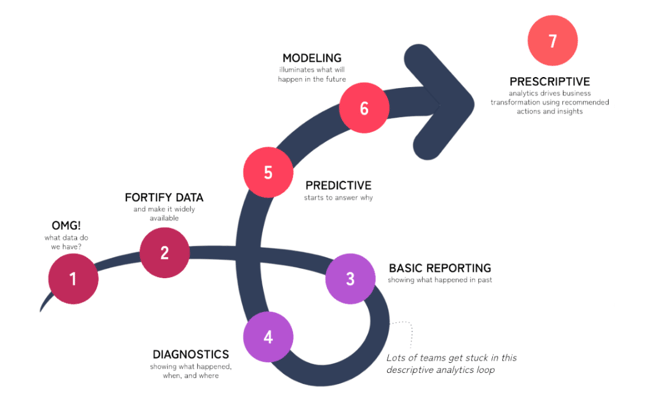This post is part of the B2B Retention Handbook series. To explore more challenges and solutions, check out the series here.
Can we predict retention or are we making assumptions based on past quarters’ numbers? If we know anything about “precedented times,” it’s that it’s become increasingly more difficult to count on our assumptions. Instead, we’ve got to use the information we have to help discover and act.
It’s not quite as easy as seeing into the future, but our data can tell a story if we know where to look. Being able to focus on what’s happening—rather than only on what happened—and getting notifications for accounts that need your attention today can help your team work to maintain relationships with current customers.
Outline
- Reasons
- Solutions
- Bonus: Don’t get stuck in a data loop. Generate valuable, timely customer insights with predictive analytics.
Reasons
How do you know if you have a retention problem? The answer may be obvious if you’ve recently lost some big customer accounts, but you may be experiencing churn in more subtle ways, including:
- Free trial or freemium accounts aren’t upgrading to paid status.
- Smaller accounts aren’t renewing, with little fanfare or even notice.
- Bigger accounts are in danger of churning, but you don’t know until it’s too late.
- You don’t have a way to monitor churn rates or other retention data and look at historical trends.
- You’re not sure what to measure or how to evaluate retention.
- You’re not sure if churn is a problem for specific kinds of accounts or if it's a more general problem.
Solutions
- Here are some of the top retention KPIs that growing companies monitor and evaluate - 10 Customer Retention Metrics & How to Measure Them | HubSpot
- Customer Retention Rate
- Customer Churn
- Revenue Churn
- Net Retained Revenue (NRR)
- Existing Customer Growth Rate
- Repeat Purchase Ratio
- Product Return Rate
- Days Sales Outstanding
- Net Promoter Score (NPS)
- Time Between Purchases
- Loyal Customer Rate
- Customer Lifetime Value
- How to measure these KPIs? You need a combination of account data, product data, and purchase data. There are numerous customer success-focused apps that do this you can compare. – Best Customer Success Software | G2
- Explore and analyze customer retention data to find trends and get messages identifying segments or individual accounts in danger of churn - Can you predict retention and churn? | Klearly
Bonus: Don’t get stuck in a data loop. Generate valuable, timely customer insights with predictive analytics.
Getting to the heart of retention issues can be uncovered by looking at the data and identifying key milestones where retention suffers. If you’ve already done the foundational work of creating processes to fortify and share your data, maybe you’re stuck in a place where your team is only making decisions about what to do by understanding what’s already happened. Oftentimes, this method of analysis happens during monthly or quarterly business reviews. The issue with this; however, is that by the time you’ve analyzed this data something else may have changed and you are no longer working in an agile way to make an impactful adjustment.

Consider adding predictive capabilities that start to help you understand why things are happening by providing context around every customer engagement throughout their journey. Modeling then helps you look for patterns or common factors that lead to both retention and churn. Finally, prescriptive analytics empowers your team to drive growth with recommended actions and insights to prevent churn and build customer loyalty.
Klearly helps teams move from a backward-looking delayed analysis loop and scalably provides predictive and prescriptive analytics in the form of real-time alerts and messages that empower your team to collaborate with agility and stop churn before it happens.



.png)

.png)
.png)